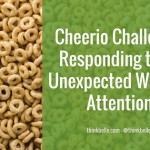Brands that succeed on social media are quick to evolve and focus on continuous improvement. Always tweaking social strategy, smart businesses look for ways to better tell their story, connect with their audience and stay in-the-know on current social trends. Need one surefire way to keep pushing yourself to be better? Keep an eye on your competition by conducting a social media competitive analysis.
A social media competitive analysis is a useful exercise to complete when you are developing your social media strategy, but it can really be done at any time. And in fact, it should be done regularly (at least every six months), so that you stay aware of what your competitors are doing and what’s trending.
Why a Social Competitive Analysis Is Valuable
Conducting a competitive analysis accomplishes several things:
- Outlines what tactics others are using to help you be smarter about your social strategy
- Gives a benchmark for you to see how your brand’s social metrics measure up
- Sparks ideas for creative campaigns or unique ways to use social channels
- Uncovers a niche or opportunity to try something no one else is doing yet
- Provides insight into what tactics have worked well (or not so well) for your competitors
- Reveals what channels/areas your competitors are focusing on, so you have a better idea of their strategy
How to Conduct a Social Media Competitive Analysis
The steps below assume that you already have a good idea of who your main competitors are. If you haven’t yet identified them, do some baseline competitive research first. Once you have a list of a few (preferably at least five) key competitors, proceed with the steps below.
Create a Competitive Analysis Doc
This can be as simple as a Google Doc, which is what we use as an agency at Belle Communications.

Here’s how you can mimic our set up: Write your own brand and the names of your main competitors down the column on the left-hand side. Then, create columns for Facebook, Twitter, Instagram and any other social networks that are commonly used by brands in your industry, such as Pinterest, LinkedIn or Snapchat (if you aren’t sure, the next step will help you determine this). You will need several columns for each social network in order to capture all relevant data.
Which Channels Are They On?
First, you need to know where your competitors have a presence in the social space. Visit each competitor’s website and look for social media icons – usually found at the top or bottom of the homepage. However, sometimes websites aren’t up to date or companies may have a presence on a social platform but not promote that on their site. For any social channels that aren’t on their site, you can be extra thorough by using each social network’s search function to double check whether a competitor has an account there.
Record each competitor’s social account URLs (or handles) in your analysis doc.

Make note of any unexpected social channels being used. Is one of your competitors heavily promoting Snapchat or highly active on Tumblr? Just because a competitor is present on a channel doesn’t mean you need to be, but it’s helpful to be aware of what they are doing and evaluate whether or not it would make sense for your brand.
Facebook Analysis
Starting with Facebook, record the number of Page Likes for each competitor. Then, look back at their posts over the past few weeks or months, and estimate their average post frequency – once per week? Multiple times per day? Add this to the analysis doc.
Facebook has a handy “Pages to Watch” feature within Facebook Insights, where you can keep an eye on your competitors on an ongoing basis. (Note: You have to be an Admin of your Page and have at least 100 Page Likes in order to use this feature.)
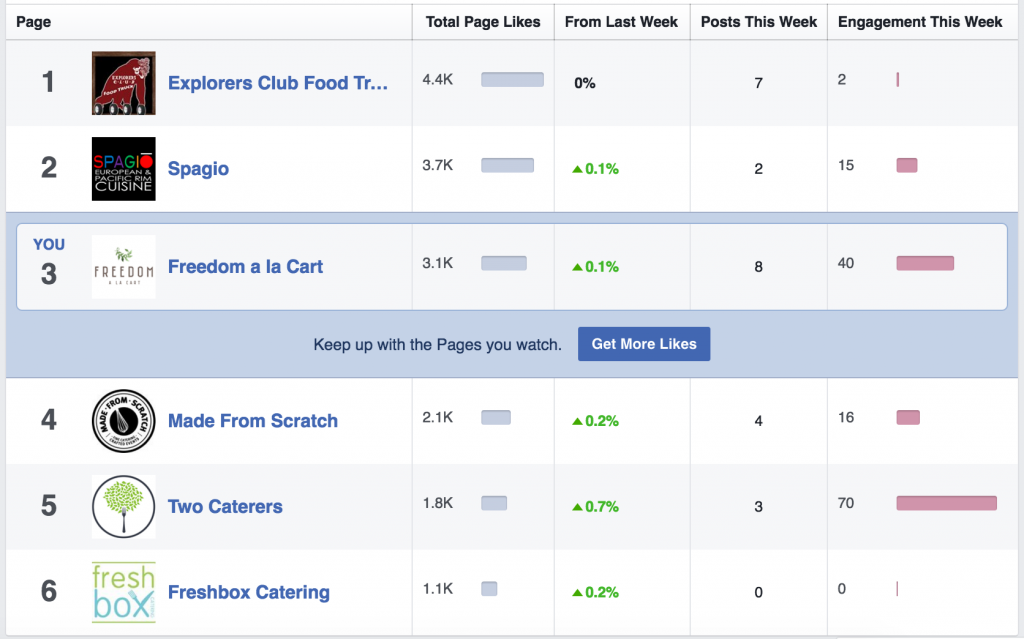
Pages to Watch will show you each brand’s total Page Likes (and % change from the previous week), number of posts shared this week, and engagement this week.
To get a more accurate engagement number for your competitive analysis (since Pages to Watch only includes a week of data), we suggest visiting each competitor’s Facebook page and looking at a few weeks/months of posts. Estimate an average number of engagements (likes + comments + shares) per post for each competitor.
Next, take the average engagements per post and divide it by their follower count to get an Engagement Rate percentage. A huge brand like Starbucks will obviously have much higher engagement per post than the locally-owned coffee shop down the street… but if the local shop has a higher percentage of engaged fans out of their total community, then that is a business doing something right on social.
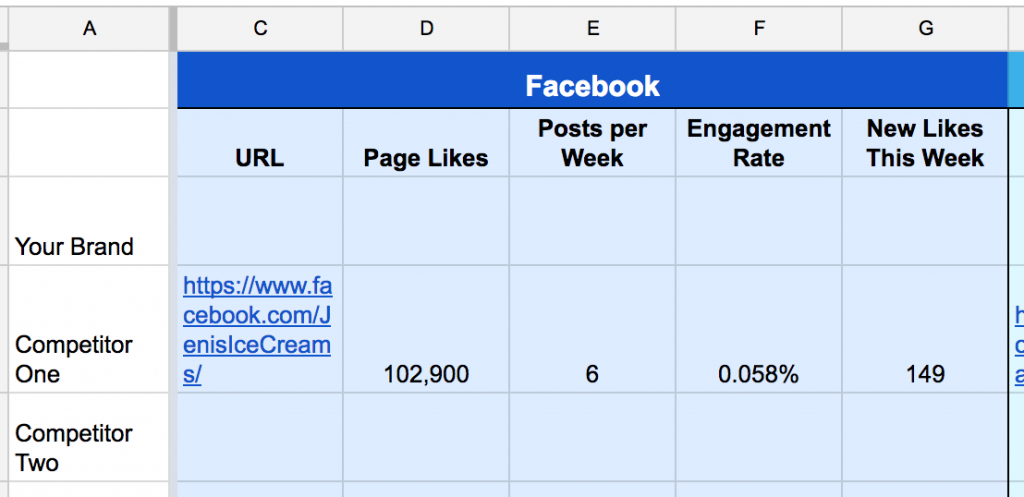
Why this information is useful: Smart marketers know that a highly engaged, loyal community of brand advocates is worth exponentially more than a huge number of indifferent followers. If one or more of your competitors has an especially engaged community, they are the one you really want to pay attention to and notice what they’re doing differently.
Tip: If you see any highly engaging posts, eye-catching visuals or creative campaigns, screenshot them and add to an “Inspiration Images” folder on your computer for times when you need to get the creative juices flowing.
Instagram Analysis
Iconosquare is a great Instagram management and analytics tool. While it’s a paid service, you can use the Iconosquare Brand Index to do some highly informative competitive research for free, if your competitors are large enough brands. The Brand Index is a catalog of 5000+ brands. Search for any brand by name and you can view info such as follower count, engagement rate, posts on hashtag, average post frequency and follower growth over the past 30 days.
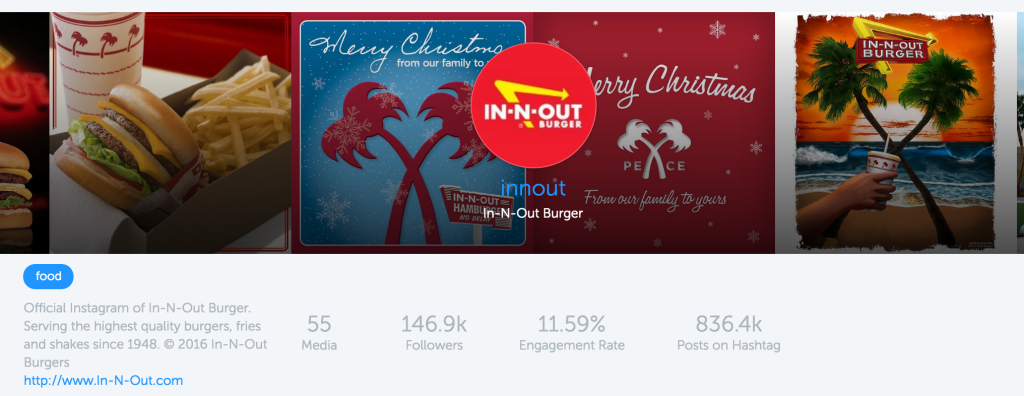
Of course, if you can’t find your competitors in the Brand Index, it isn’t hard to gather the info manually. Start by recording the follower count. For engagement rate, a quick way to calculate this is to visit their Instagram account on mobile and click on the “scroll” display icon. This way, you can quickly scroll through each post they’ve shared recently to see the number of likes and comments, so you can figure out an average engagement rate. Use this same method to determine post frequency.
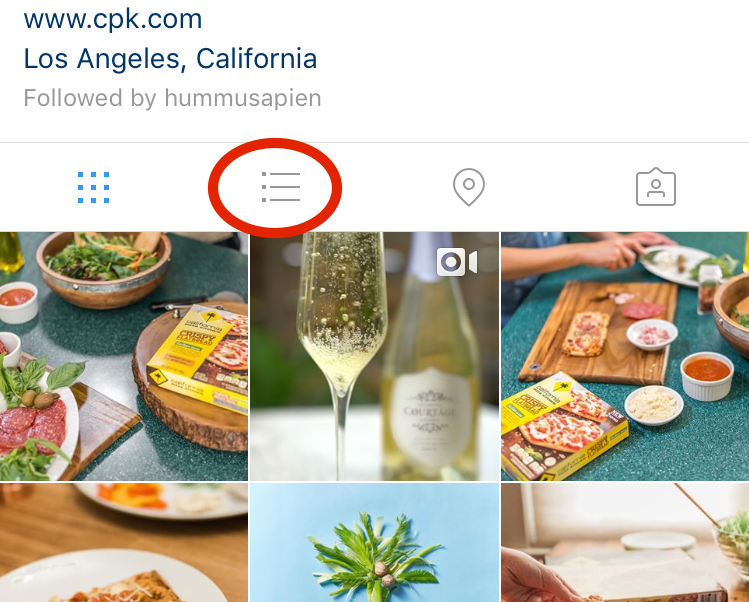
The last step (if you weren’t able to use the Brand Index) is to search for the brand’s hashtag using Instagram’s search function (for instance, #chipotle). Record the number of posts that have been shared using that hashtag.
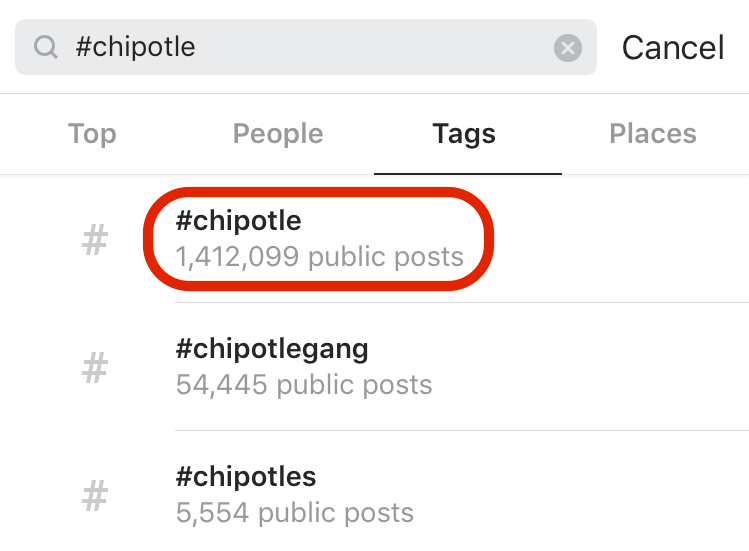
Twitter Analysis
For insights on your competitors’ Twitter activity, check out a fantastic free tool called Twitonomy. You can view tons of useful info with the free version, and there’s also a paid version if you want to dig even deeper. You can analyze your own account and any other handle on Twitter.
With Twitonomy, you can view info such as how many total tweets they have shared in a given time frame, average tweets per day, number of tweets that have been retweeted and favorited, and more. (Note: date range is determined by Twitonomy and cannot be adjusted in the free version.)

For our competitive analyses, we generally record the tweets per day and the “tweets retweeted” percentage, which shows what percentage of their tweets have been retweeted by others.

But you can also find tons of other useful info in Twitonomy, such as most frequently used hashtags…
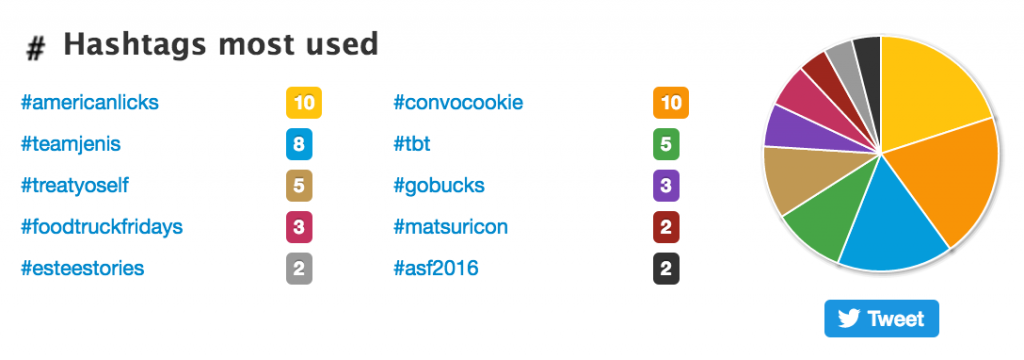
…tweets most retweeted and favorited…
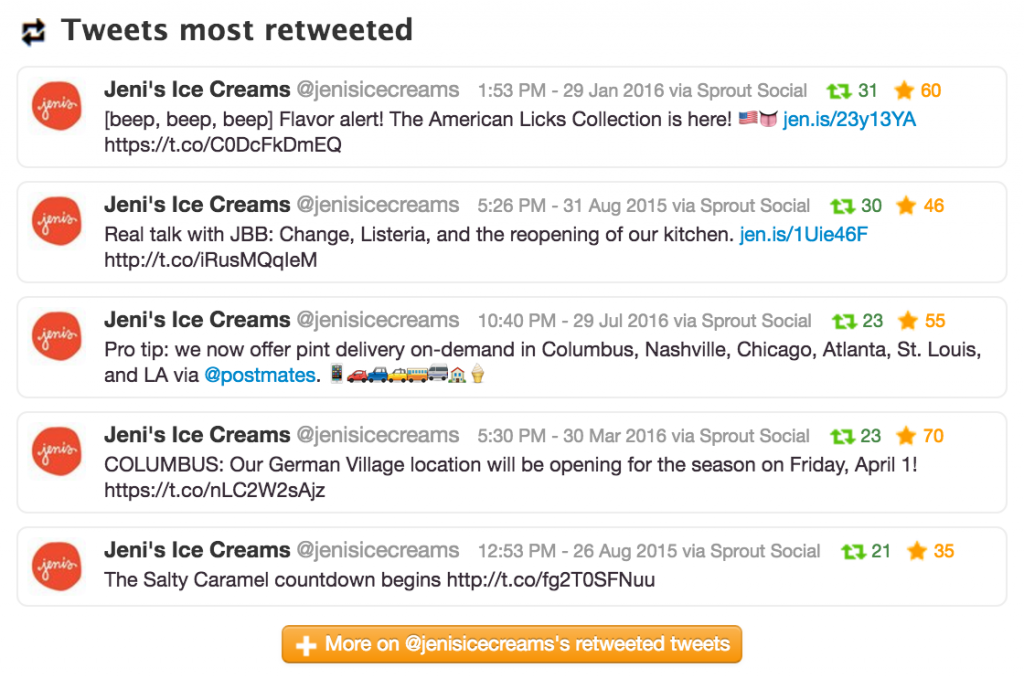
…and breakdown of when the competitor tweets, by day and time. You can even see users they most frequently engage with – and again, this is all info that is available in the free version!
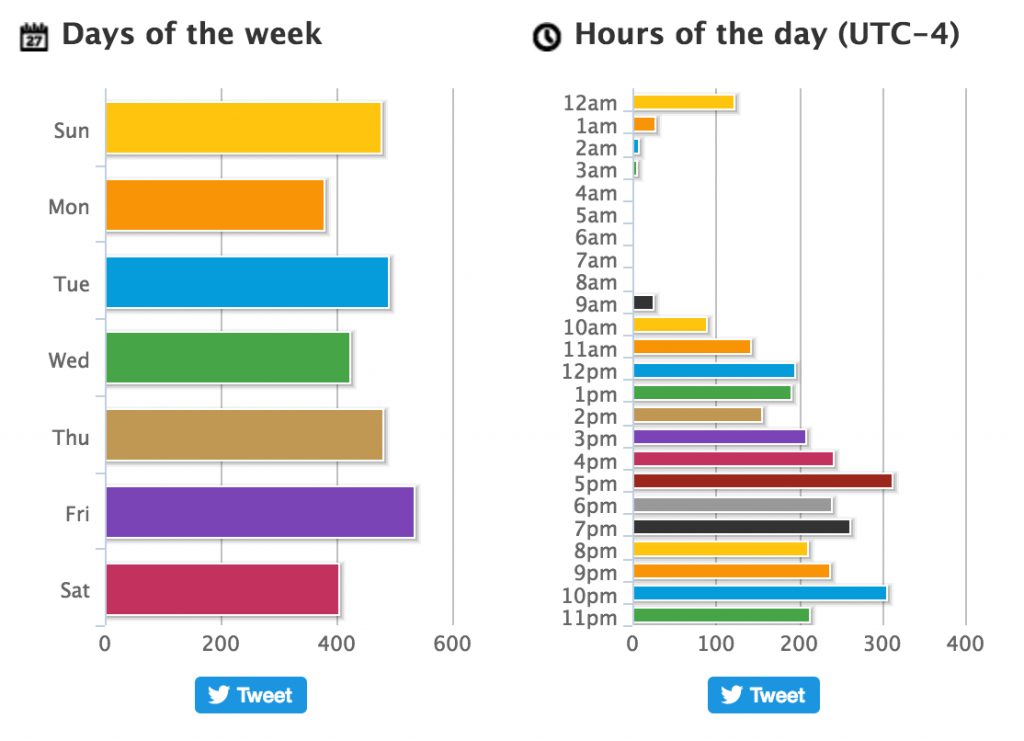
If you use a more robust social management tool such as Sprout Social, you can get even more Twitter data from their analytics reports, such as Engagement and Influence scores and brand mentions.
Other Social Channels
You’ll want to add data for any other major social networks that your competitors have a presence on, which may vary by what industry you are in. If you’re B2B, LinkedIn is a biggie, and Pinterest is a must-have channel for most retail brands. For these or any others that are being used by your competitors, add the following information to your analysis doc:
- URL
- Follower count
- Average post frequency
- Engagement rate (average engagements per post divided by follower count)
Bringing It All Together
So you’ve done all this research and gathered the data … now what? The point of doing a social media competitive analysis is not to copy your competitors’ ideas or do all the same things they are doing. The goal here is to better understand how your social presence compares to others in your industry and to identify areas where you can improve.
Look at your competitive analysis doc and make note of any areas where your numbers are significantly different from the competition – then, use that knowledge to tweak your social strategy. If your follower counts are low, maybe it’s time to invest in some targeted social media ads to grow your community. If your engagement is low, brainstorm some ideas and look at the types of content that seem to be resonating well with your competitors’ audiences.
Even better, a competitive analysis might show an opportunity for your brand to be ahead of the curve with a new social trend. If it makes sense for your target audience demographic and you have the resources to do it right, why not be the first ones to do a Facebook Live broadcast or use Instagram Stories? The possibilities are endless. There’s much that can be gained from knowing your competitive landscape, so keep a close watch and always be looking for ways to up your own social game.
Interested in more insights? Subscribe to trending, a free monthly report for senior marketers designed to help lift the burden of social listening and research to better inform future strategy and real-time decision-making. Leveraging our team’s skill for being on the pulse of what’s now and next, our goal is to inform and equip through insight into the latest culture, media and social trends.



